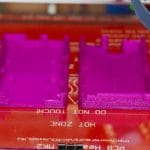A year in 3D printing – 2019
So here we are at the start of a new year. Christmas was last week, and I imagine quite a lot of you got a new 3D printer from Santa and have been having fun with it. Hopefully our Christmas printer suggestions came in handy for some of you, too. We’d like to think we’ve helped with the country’s output of small plastic Star Wars figures and custom dog bowls.
What was the bigger picture for 3D printing in 2019, though? Well, it’s been pretty interesting! The technology is really going mainstream now, and it was used for some pretty impressive things last year. Let’s take a look at a few.
On the catwalk
Firstly, New York’s leading fashion show, the Met Gala, featured quite a few designs that featured 3D printing. US designer Zac Posen was responsible for most of it, including a transparent bustier, an elaborate collar decoration worn by actress Katie Holmes and simulated embroidery on Bollywood sensation Deepika Padukone’s outfit. Most impressive of all was an elaborate gown for supermodel Jourdan Dunn. This was based round a 3D-printed titanium cage sized to fit a 3D model of Dunn’s body, which served as a base for 21 large, flexible printed rose petals.
Big boys’ toys
The University of Maine decided to stick with printing plastic toys, but they got ambitious with the scale – and they also scooped three Guinness world records. First they built the world’s largest polymer 3D printer. Then they used it to print a 25-foot speedboat, which is both the largest 3D-printed boat and the largest solid printed object. Impressively, the 2.4-ton boat took just 72 hours to print. The printer itself uses wood-filled material derived from Maine’s forestry industry and has a 100x22x10-foot print volume. The university is already collaborating with the US Army to print rapidly deployable shelters.
Go with the flow
Chinese engineers also went large, printing the parts needed to build a river revetment almost 1,700 feet long near the port of Shanghai. Revetments protect river banks against undermining by the wash from ships, and traditionally they’ve been built of wood, stone or concrete blocks; 3D printing with a concrete compound allows custom block shapes to be rapidly made, so the revetment can follow the shape of the river bank more closely. This makes it more durable and avoids causing unpredictable changes to the river’s flow.
Ship shape
Finally, Huntington Ingalls Industries-Newport News Shipbuilding has used a sophisticated metal printer they installed last year to create a new pipe assembly for one of the world’s ultimate high-performance systems – the nuclear-powered steam plant on a US Navy aircraft carrier. The deceptively small part (it’s about the size of a grapefruit) is a valve that lets water be drained from the carrier’s steam pipes while the reactor is running. That means it has to be precisely made to avoid leaks, and immensely strong to withstand steam pressures that can drive a 103,000-ton carrier at almost 40mph. The part will be installed on USS Harry S Truman later this year.
So, everything from fashion to fighting ships – 3D printing in 2019 is really staring to make its mark on industry. Additive manufacturing isn’t experimental anymore; it produces things that perform well in real applications, and it can make objects that are impossible to create using traditional methods. In the next few weeks we’ll take a look forward to what’s likely to happen in 2020; it should be exciting!








Leave a comment
You must be logged in to post a comment.